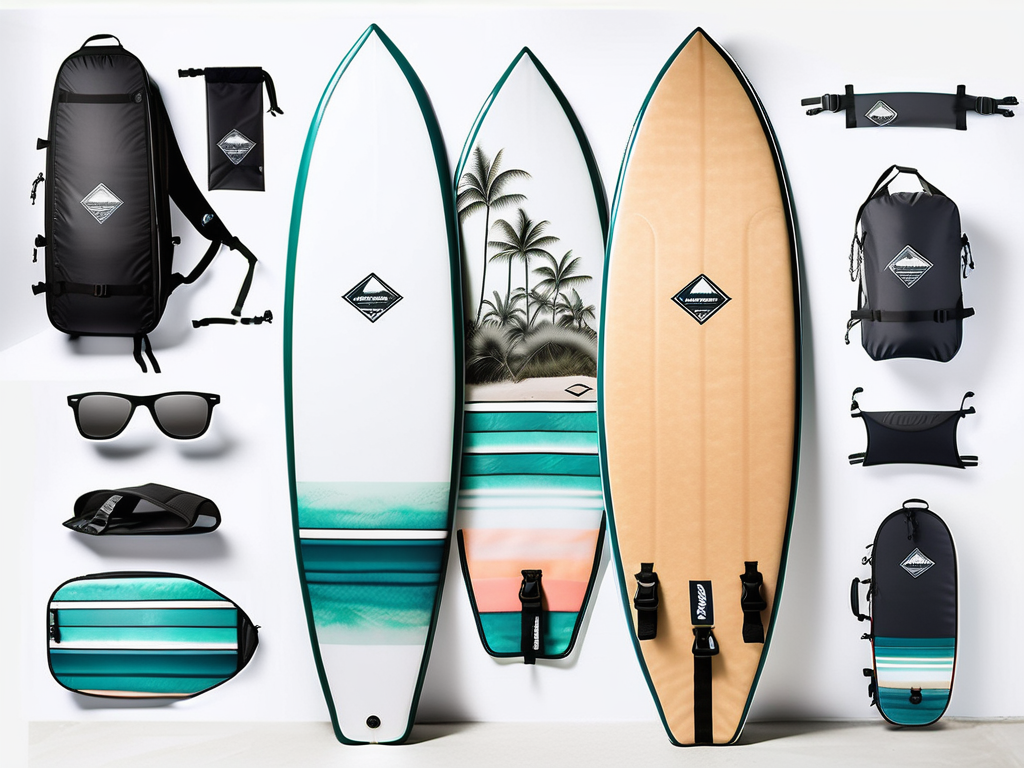The Ultimate Guide to Traveling with Your Surfboard: Must-Have Accessories
Traveling with your surfboard requires careful planning and the right accessories to ensure a smooth journey and maximum protection for your board. In this ultimate guide, we will explore the must-have accessories that every surfer should consider when taking their surfboard on the road.
Essential Surfboard Accessories for Every Surfer
Surfboard bags are an absolute necessity for surfers who frequently travel. These bags not only provide protection against scratches, dings, and UV rays but also offer convenience in transporting your board. Here are some top picks for surfboard bags in 2023:

Must-Have Surfboard Bags for 2023
1. [Brand A] Deluxe Travel Surfboard Bag: This bag is designed specifically for air travel, with extra padding and reinforced materials to withstand rough handling. It also features heavy-duty zippers and multiple handles for easy carrying.
2. [Brand B] Daylight Surfboard Bag: Ideal for short trips or day trips to the beach, this lightweight bag offers protection against scratches and UV rays. It comes with a detachable shoulder strap for easy transport when you're on the go.
3. [Brand C] Coffin Surfboard Bag: Perfect for surfers who travel with multiple boards, this bag provides ample space for two or more boards. It features durable construction, thick padding, and wheels for easier mobility.
Investing in a high-quality surfboard bag not only protects your board but also prolongs its lifespan, ensuring that it remains in top shape for years to come.
Top Picks for Surfboard Protection
In addition to a surfboard bag, there are other accessories that can further enhance the protection of your board during travel. Here are some top picks:
- 1. Surfboard Socks: These lightweight and stretchy covers offer an extra layer of protection against minor dings and scratches. They are easy to slip on and off your board and are ideal for day trips or short-distance travel.
- 2. Nose Guards and Tail Guards: These protective covers attach to the nose and tail of your board to prevent damage from impacts and rough handling. They are particularly useful when transporting your board in crowded surfboard racks or car trunks.
- 3. Rail Savers: These adhesive strips provide added protection to the rails of your board, which are prone to scratches and dings. They are easy to apply and remove, and they offer peace of mind during travel.
By combining these additional accessories with a surfboard bag, you can ensure that your board is well-protected throughout your journey.
Surfboard Maintenance 101: Keeping Your Board in Top Shape
While traveling with your surfboard, it's essential to practice proper maintenance to keep your board in top shape. Here are some maintenance tips:
- 1. Rinse Your Board: After every surf session, rinse your board with fresh water to remove salt, sand, and other debris that can cause damage over time.
- 2. Check for Damage: Before and after each trip, inspect your board for any signs of damage, such as cracks or dings. Repair them promptly to prevent further issues.
- 3. Wax Removal: Regularly remove old wax and apply a fresh coat. This not only improves traction but also helps protect the board's surface.
- 4. Fins Care: Inspect your fins and ensure they are securely attached. Consider removing them during travel to prevent damage.
By following these maintenance practices, you'll extend the lifespan of your surfboard and ensure its optimal performance during your surfing adventures.
Now, let's dive deeper into the world of surfboard bags. When choosing a surfboard bag, it's important to consider the length and width of your board. A bag that is too small may not provide adequate protection, while a bag that is too large may be cumbersome to carry. Additionally, look for bags with extra padding in critical areas, such as the nose and tail, as these are more prone to damage during travel.
Another important factor to consider is the material of the bag. High-quality surfboard bags are typically made from durable and water-resistant materials, such as nylon or polyester. These materials help protect your board from moisture and ensure that it stays dry even in wet conditions.
Some surfboard bags also come with additional features, such as built-in compartments for storing fins, wax, and other accessories. These compartments can help keep your gear organized and easily accessible, saving you time and effort when setting up for a surf session.
When it comes to surfboard socks, there are a variety of options available. Some socks are designed specifically for shortboards, while others are suitable for longboards or fish-shaped boards. Look for socks that are made from stretchy and durable materials, as they will provide a snug fit and better protection for your board.
As for nose guards and tail guards, these accessories are often made from impact-resistant materials, such as rubber or foam. They are designed to absorb the impact of accidental bumps or rough handling, preventing damage to the delicate nose and tail areas of your board.
Rail savers, on the other hand, are adhesive strips that can be applied to the rails of your board. These strips act as a barrier between your board and any hard surfaces it may come into contact with, reducing the risk of scratches and dings. Rail savers are particularly useful when transporting your board on a roof rack or in a surfboard bag with multiple boards.
By taking the time to choose the right surfboard accessories and practicing proper maintenance, you can ensure that your board remains in excellent condition, ready to ride the waves whenever and wherever you go.
Safeguarding Your Surfboard During Travel
Common Surfboard Damage Areas to Watch Out For
During travel, your surfboard can be subjected to various risks and potential damage areas. Here are the common ones:

- 1. Airlines Mishandling: Baggage handlers may mishandle your board, leading to dings, cracks, or even breakage. Be sure to pack your board properly and consider additional insurance when flying with your surfboard.
- 2. Temperature Extremes: Extreme heat or cold can affect the integrity of your board. Avoid leaving it in the sun or exposing it to freezing temperatures for extended periods.
- 3. Improper Storage: If you're traveling by car or other means, make sure your board is properly secured to prevent it from shifting or colliding with other objects during transit.
By being aware of these potential damage areas, you can take the necessary precautions to protect your surfboard throughout your journey.
Pro Tips for Extending Your Surfboard's Lifespan
Properly Removing Fins for Board Protection
When traveling, consider removing your fins to minimize the risk of damage. Here's how:
- 1. Loosen Fin Screws: Using a fin key, gently loosen the screws that secure your fins to the board. Avoid overtightening or applying excessive force.
- 2. Remove Fins: Once the screws are loose, carefully slide the fins out of their fin boxes. Place them in a safe and protective container or bag.
- 3. Secure Fin Boxes: Before storing your fins, make sure to secure the fin boxes with fin plugs or covers to prevent debris from entering.
By removing your fins, you reduce the risk of them getting damaged during transit and protect your surfboard from unnecessary pressure.
Why Removing Your Leash Matters
While it may seem convenient to leave your leash attached to your board during travel, it's actually best to remove it. Here's why:
1. Avoid Tangling: Leashes can easily get tangled, leading to potential damage to your board or leash itself during transport.
2. Reduce Pressure Points: Leaving your leash attached can create pressure points on your board, which may result in dings or cracks.
3. Prevent Theft: Detaching your leash ensures that it doesn't catch the attention of potential thieves, reducing the risk of board theft.
By taking a few moments to remove your leash, you eliminate potential risks and help keep your board safe.
The Importance of Removing Surf Wax
Before traveling with your surfboard, it's crucial to remove the wax. Here's why:
- 1. Prevents Melting: Wax can melt during hot weather, leaving a sticky mess on your board and potentially damaging it.
- 2. Minimizes Sand Build-Up: Wax attracts sand particles, which can scratch the surface of your board if not removed. Additionally, sand residue can damage board bags or other accessories.
- 3. Allows Inspection: Clearing the wax allows for a closer inspection of your board's surface, enabling you to identify any potential damages or areas in need of repair.
By removing the wax, you not only protect your board but also ensure a cleaner and hassle-free travel experience.
Expert Advice for Surfboard Care
When it comes to caring for your surfboard, we reached out to renowned surfboard shaper [Name], who shared some expert advice:
"Regularly inspect your board for any signs of damage and address them promptly. Additionally, invest in a good quality surfboard repair kit that includes essentials like epoxy resin, fiberglass cloth, and sanding tools. Having these items on hand allows you to make quick repairs during your travels and keep your board in great condition."
Following the advice of experts like [Name] can help you maintain your surfboard's performance and ensure its longevity.
Essential Items in a Surfboard Repair Kit
A surfboard repair kit is an essential accessory for every surfer, especially when traveling. Here are some must-have items to include in your kit:
- Epoxy Resin: A strong and durable adhesive used for repairing dings and cracks.
- Fiberglass Cloth: Provides reinforcement when repairing larger damages.
- Sanding Tools: Assortment of sandpaper grits and a sanding block to shape and smooth repairs.
- Finishing Coat: A topcoat or gloss resin for finishing the repairs and giving your board a polished look.
- Disposable Gloves: Protect your hands while working with resin and other repair materials.
- Plastic Mixing Cups and Stir Sticks: Essential for accurately measuring and mixing resin.
Having a well-stocked repair kit allows you to handle minor repairs while traveling, saving you time and money.
Navigating Local Travel with Your Surfboard
When traveling to surf destinations, it's crucial to research and plan for local transportation options. Here are some tips:
- 1. Check Local Laws and Regulations: Some areas enforce specific regulations for transporting surfboards. Ensure that you comply with any requirements, such as using soft racks or board covers.
- 2. Rent a Surfboard: If you're traveling a long distance or to a remote location, consider renting a surfboard instead of bringing your own. This can minimize potential travel hassles and save you from worrying about board transportation.
- 3. Seek Local Advice: Reach out to local surf shops or online surf communities for advice on the best transportation methods at your destination. Locals often have valuable insights and recommendations.
By being well-prepared and considering local factors, you can focus on enjoying the waves instead of worrying about surfboard logistics during your trip.
In Conclusion
Traveling with your surfboard doesn't have to be stressful. By investing in essential accessories, practicing proper maintenance, and following expert advice, you can ensure that your board stays protected and in optimal condition throughout your surfing adventures. So, pack your gear, hit the road, and get ready for unforgettable surf sessions in your dream destinations!






